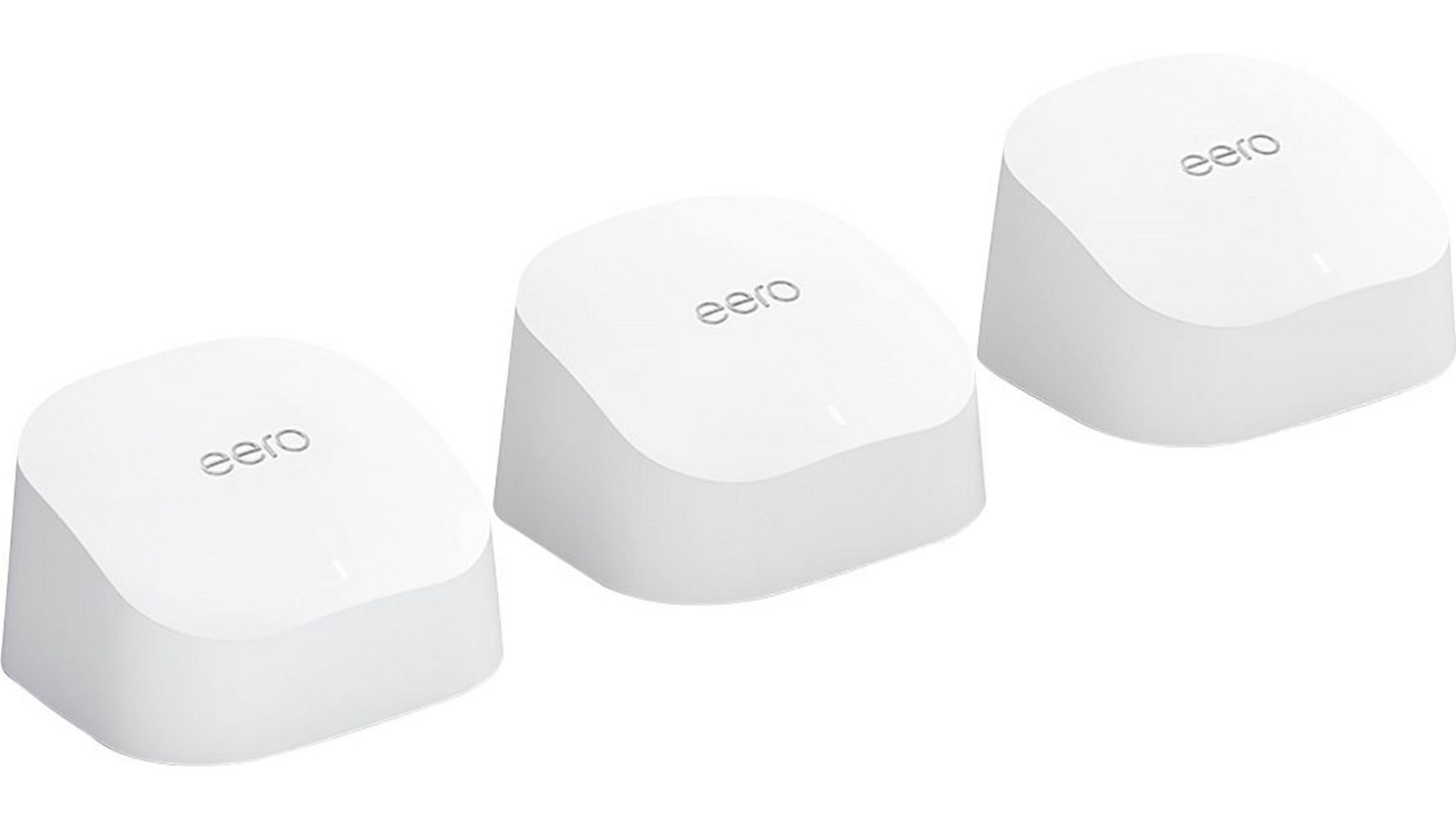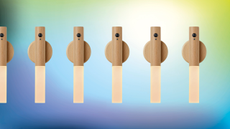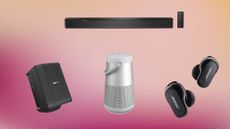Best mesh Wi-Fi systems: the best options to eliminate dead spots
The best mesh Wi-Fi system bundles from TP-Link, Eero, Google, Linksys, and more


The internet has become an essential part of the fabric of modern life, and our homes are full of connected devices that need a strong and reliable internet connection to function. It can be frustrating, then, when the wireless signal from your router doesn’t reach far enough to cover all the areas of your home. Even if the area you’re trying to cover isn’t particularly large, you may find that thick walls are blocking the signal to some rooms.
Thankfully, mesh Wi-Fi networks can help solve this problem. Rather than having one central router serving your entire property, mesh networks work by establishing a series of interconnected nodes placed throughout your home, all connected to each other. This allows devices to automatically connect to whichever one offers the best signal, meaning you can move around freely without your connection dropping.
This is different from the best WiFi extenders, which offer a lighter touch when expanding the reach of your existing internet connection.
If this sounds complex, don’t worry - modern mesh networks are designed to be easy to set up and manage via user-friendly mobile apps. There are options to suit a wide variety of needs and budgets, and we’ve rounded up our picks for the best mesh Wi-Fi networks to help eliminate Wi-Fi dead spots in your home.
The best mesh Wi-Fi systems in 2024
Livingetc knows design.
Best mesh Wi-Fi system overall

1. Linksys Atlas Max AXE8400 Tri-Band Mesh Wi-Fi 6E System
Specifications
Reasons to buy
Reasons to avoid
Our top choice for the best mesh Wi-Fi system is this Wi-Fi 6 kit from Linksys. The MX8400 offers impressive performance, albeit at a decidedly expensive cost. The triple-band Wi-Fi 6 setup gets you a very capable level of range and speeds, and with a generous complement of four gigabit Ethernet ports and one USB port per node, you won’t be short of physical connections for other devices.
It is, for our money, one of the most distinctive mesh kits around. Each mode is a square column standing just over 24cm high, which may make them tricky to fit into a bookshelf or tuck out of the way. The app-based setup is nice and straightforward, though, so you should have little trouble getting up and running.
Best mesh Wi-Fi system for smart homes

2. Google Nest Wi-Fi AC2200
Specifications
Reasons to buy
Reasons to avoid
Google’s design philosophy is based on simplicity above all else, and that’s certainly the case with its Nest Wi-Fi system. These almost featureless rounded pods are unassuming enough to fit into almost any room and come in three flavors. There’s the main hub unit, which connects to your modem to handle routing duties, and smaller satellite units that are placed throughout the rest of the house.
The smaller nodes hide a clever secret, though: they also act as smart speakers, with built-in functionality allowing you to do things like control smart home devices, play music, or set timers. For most people, this may go some way to making up for the lack of Wi-Fi 6 support, which means that newer devices won’t be able to take advantage of quite as much speed and coverage as with other systems on this list.
- Having trouble connecting? Here's our guide to what to do when you're left asking 'what is wrong with my WiFi?!'
Best value Wi-Fi 6 mesh system

3. TP-Link Deco X20 Wi-Fi 6 Mesh System
Specifications
Reasons to buy
Reasons to avoid
While the cylindrical white design of TP-Link’s Deco X20 kit may be somewhat uninspired, reminiscent of a coffee can if Apple created it, its price tag is more attractive. What’s more, it comes with three nodes, which can be spaced out around the house for increased coverage. They support the latest Wi-Fi 6 standards, too, which gives a further boost to both coverage range and connection speeds.
While the Deco X20 system isn’t the fastest in terms of raw performance, there’s plenty of headroom to have multiple people streaming 4K video, conducting video calls, or gaming online without stuttering or lag, and TP-Link also includes additional features to help take care of security, as well as a suite of parental control tools.
One drawback is a comparatively limited number of ethernet ports on each device, however, so bear this in mind if your home network has a lot of devices you’d like to connect physically.
Best mesh Wi-Fi for easy setup

4. eero 6 AX1800 Dual-Band Wi-Fi 6 Mesh Wi-Fi System
Specifications
Reasons to buy
Reasons to avoid
Amazon’s answer to the likes of Google's Nest Wi-Fi, the Eero 6 Mesh Wi-Fi 6 kit, offers solid (if unremarkable) speeds at a reasonable price. They’re also among the smallest and least obtrusive units we’ve seen and are easily placed around the home without drawing too much attention.
The system’s real strength, however, is in how easy it is to set up and manage via the companion smartphone app. There’s also an optional security subscription, for which a year’s free trial is included with the purchase. It’s not a stand-out system in any one particular area, but it represents an excellent all-rounder for those that want fuss-free Wi-Fi throughout the home.
Best mesh Wi-Fi for large houses

5. Netgear Orbi AX4200 Tri-Band Mesh Wi-Fi 6 System
Specifications
Reasons to buy
Reasons to avoid
What the large, imposing lozenges of the Netgear Orbi RBK752 system lack in subtlety, they make up for in range. Connection speeds with most routers will start dropping the further you get from the access point, but the Orbi remains remarkably consistent when roaming around the house. Speeds are strong, too, although not the absolute fastest available, and Wi-Fi 6 compatibility ensures that your network will be in good shape to support any new devices you buy in the next few years.
You’re paying a premium for it, however, and it’s one of the more expensive kits on this list, particularly considering that additional features like parental control systems are in short supply. With that having been said, however, these extra bells and whistles often feel like gilding the lily, and if all you need is bulletproof wireless coverage for a large property, the RBK752 delivers in spades.
Best budget mesh Wi-Fi system

6. Tenda Nova MW6 Mesh Wi-Fi System
Specifications
Reasons to buy
Reasons to avoid
If you’re looking for mesh Wi-Fi on a budget, then look no further than the Tenda Nova MW6. This three-node kit is the cheapest on this list, but the price does come with some compromises. For starters, it’s using the older Wi-Fi 5 standard, so don’t expect it to be as fast or to cover as much distance as newer Wi-Fi 6 systems, and it’s not the most visually appealing system we’ve seen.
On the other hand, however, although it’s a little long in the tooth compared to some of the other entries on this list, it's hard to argue with the value the MW6 system represents, and it’ll still provide perfectly capable coverage for most homes, particularly if you’re not covering a large space or trying to support a large number of simultaneous downloads.

How to choose the best mesh Wi-Fi system for your home
Wi-Fi 5 vs Wi-Fi 6
Wireless technology is continually improving, and the most recent standard is known as Wi-Fi 6. It offers better speed, stability, and range than previous versions of the technology, but there are a few things to consider before you make your purchase.
Firstly, because the standard is still relatively new, mesh systems that are Wi-Fi 6 compatible tend to be more expensive than those using older versions of the technology. Similarly, your devices won’t be able to take advantage of the speed improvements it offers unless they’re also compatible. Most smartphones, tablets, and laptops released in the last couple of years are likely to support Wi-Fi 6, but if you’re not planning on upgrading for a few years, you may want to opt for a cheaper Wi-Fi 6 system.
However, investing in a Wi-Fi 6 mesh system now will likely mean you won’t have to upgrade to a new Wi-Fi system for some time, and the benefits for range and coverage are worth considering even if you won’t be buying a new phone in the near future.
How many Ethernet ports do I need?
Although wireless connections are incredibly versatile, hooking your devices up via a cabled connection is guaranteed to deliver the best speeds with maximum reliability. If you want to connect any devices like smart home hubs, game consoles, or desktop PCs to your router, you may want to check whether the nodes of a specific mesh system have enough physical ethernet ports to accommodate all the devices you want to use.
Most mesh systems tend to have two or three ports per node, and while you always have the option of using a small network switch to increase the number of ports you have available, this means more wires and boxes to keep tidied away out of sight.
What about management and security?
Most mesh Wi-Fi systems have their own app for setting them up and configuring various settings, but while these are usually straightforward and user-friendly, they aren’t particularly deep in terms of their configuration options. If you’ve got specific plans for how you want to configure the finer points of your home network, it’s important to check whether the app will allow you to configure the specific settings you want to change easily.
Some mesh systems will also come with built-in security features. These are nice to have and can offer peace of mind that your personal information isn’t going to be exploited, so these features are worth setting up if they’re available. If not, you can always invest in a low-cost antivirus package to help keep your family’s devices secured.
How many nodes do I need?
If you’ve got a large property that you want to cover, you’ll need to think about how many nodes you’ll need. Most mesh Wi-Fi systems are available in bundles with multiple nodes - usually two or three - but for especially big houses, you may want to consider purchasing additional nodes on top of that.
However, given that the average US home is around 1,600 sq. ft., and most mesh systems are rated for at least that distance, the standard bundle should be more than enough to meet the needs of the majority of home networks.
How we chose the best mesh Wi-Fi systems in this guide
The entries on this list were chosen through comparing user reviews, tapping into team Livingetc's breadth of knowledge in the home tech realm, and digging down into the specs and design elements of the most popular models across a range of price points.
While we attempt to have direct experience with and independent reviews for everything we include in our guides, this is unfortunately not always possible, so some of our guides are put together using the writer's research and existing expertise. We will return to this guide regularly to update the models included, whether due to the latest releases and moves in the industry or the opportunity to test the best mesh Wi-Fi systems in person and judge them accordingly.
Models we have tested will be clearly signposted within the article, so you can trust us to be transparent with our choices. You can head to our dedicated page to learn more about our review process.
Be The First To Know
The Livingetc newsletter is your shortcut to the now and the next in home design. Subscribe today to receive a stunning free 200-page book of the best homes from around the world.

Adam is a technology journalist with a passion for devices, networking and gadgets of all kinds. Over the course of his career, he’s seen the spread of 5G, the growing ubiquity of wireless devices, and the start of the connected revolution. He’s also been to more trade shows and technology conferences than he cares to count. When not serving as reviews editor for one of the UK’s leading business technology publications, he is on a never-ending quest to make his home as smart as possible, and to build the ultimate home cinema system, along with spending far too much time on Twitter and obsessing about his broadband speed.
-
 How to Thaw a Frozen Pipe — Learn Everything You Need to Know in 5 Minutes With This Guide
How to Thaw a Frozen Pipe — Learn Everything You Need to Know in 5 Minutes With This GuideWinter storm caught you off guard? We asked an expert — just how do you thaw a frozen pipe?
By Hugh Metcalf Published
-
 The 12 Very Best Silk Bedding Pieces — As Our Style Editor Says: 'It's What Dreams Are Made Of!'
The 12 Very Best Silk Bedding Pieces — As Our Style Editor Says: 'It's What Dreams Are Made Of!'Slumber in lustrous luxury with the very best silk bedding sheets, duvets, pillowcases, and more — your sleep score will thank us later
By Julia Demer Published
-
 These Viral $40 Lights Make Your Home Easier to Live In — And They're Pretty Chic, Too
These Viral $40 Lights Make Your Home Easier to Live In — And They're Pretty Chic, TooThese Scandi-inspired wall sconces are the lighting solution you didn't know you needed. I'm so taken by them!
By Brigid Kennedy Published
-
 It's not too late to grab a Bose speaker for up to a third off in the Prime Day sales - here are the top bargains
It's not too late to grab a Bose speaker for up to a third off in the Prime Day sales - here are the top bargainsWe've scoured Amazon for the best Prime Day Bose deals this year, but you'd better be quick!
By Caroline Preece Published
-
 If you've been thinking about buying a Ring doorbell, now's your chance - even the newest model is on sale for Prime Day!
If you've been thinking about buying a Ring doorbell, now's your chance - even the newest model is on sale for Prime Day!Looking for a Prime Day Ring deal? You've come to the right place...
By Caroline Preece Published
-
 Super cute - and easy for you to control - the best smart speakers for kids make parenting a little simpler
Super cute - and easy for you to control - the best smart speakers for kids make parenting a little simplerEnjoy music and stories with our edit of the best smart speakers for kids plus advice on what to look for when choosing an age-appropriate design
By Emily Peck Published
-
 Ring Alarm System (2nd Gen) review: the brand's made-over kit is still a winner
Ring Alarm System (2nd Gen) review: the brand's made-over kit is still a winnerWe tested the Ring Alarm System 5-Piece Kit to see if it could make home security simpler for the average user, and how it may have improved on the first gen system.
By Caroline Preece Published
-
 eufy Home Alarm Kit review: a simple but effective way to keep your home safe
eufy Home Alarm Kit review: a simple but effective way to keep your home safeThe eufy Home Alarm Kit has all of the basics on paper, but we wanted to test it out on our own home to see how easy it is to set up and use.
By Caroline Preece Published
-
 HomePod mini vs Sonos One: two high-end smart home hubs, but which is the better speaker?
HomePod mini vs Sonos One: two high-end smart home hubs, but which is the better speaker?We take a look at the HomePod mini and Sonos One, both of which sit at the higher end of the smart speaker market.
By Caroline Preece Published
-
 AirTags vs Tile: which Bluetooth tracker is best to help a case of constantly misplaced keys?
AirTags vs Tile: which Bluetooth tracker is best to help a case of constantly misplaced keys?If you're tired of losing your items, either around the house or outside, then Bluetooth trackers are a lifesaver - but which is best?
By Caroline Preece Published









